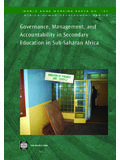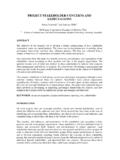Transcription of DRAFT ACTION PLAN FOR BETTER LOWER …
1 BETTER POLICIES FOR BETTER LIVES. OECD-NORWAY IMPROVING SCHOOLS REVIEW. DRAFT ACTION PLAN FOR BETTER LOWER secondary education . IN NORWAY. RESULT OF THE OECD SEMINAR FOR NORWEGIAN LEADERS IN education . IMPROVEMENT (ONTARIO, CANADA 7-10 JUNE 2012). Related report: Improving LOWER secondary Schools in Norway (OECD, 2011). This document contains an ACTION plan proposal to raise performance in LOWER secondary schools in Norway, which has been developed by 30 key Norwegian education policy makers during the OECD. Seminar for Leaders in education Improvement in June 2012. The ACTION plan targets improvement of LOWER secondary education in Norway based on the objectives of the Norwegian White Paper on Quality in LOWER secondary education (2011), as well as the recommendations of the OECD developed with an international expert group (Improving LOWER secondary Schools in Norway), and the work undertaken in the OECD Seminar with academics from Harvard Graduate School of education , the Ontario Institute for Studies in education (OISE) and a great variety of Ontario education actors.
2 This DRAFT ACTION plan has been used by Norwegian stakeholders to guide further discussions to shape new education policy efforts. The Ontario experience and OECD recommendations for Norway published in the report Improving LOWER secondary Schools in Norway show the importance of coherence, focus (prioritizing a few important goals), alignment (a clearly designed strategy that is followed through in implementation), support (aligning resources at all levels for capacity building in teaching and leadership to succeed in the agreed priorities), and communications (across levels, both horizontal and vertical, to inform and engage key stakeholders in the process). This ACTION plan follows these premises: 1. It presents four coherent and aligned actions to raise student performance in LOWER secondary . 2. It does so by focusing on improving literacy, numeracy and classroom management.
3 3. It proposes key activities to achieve the 4 actions. 4. It proposes indicators on how to measure progress. 5. It defines the actors that will be responsible and accountable for the actions. 6. It provides support material to help think through the implementation of the plan in terms of timing, priorities, resources, etc. 2. Introduction and background: DRAFT ACTION plan for BETTER LOWER secondary in Norway From 7-10 June 2011, a group of 30 Norwegian key education stakeholders came together for the OECD. Seminar for Norwegian Leaders in education Improvement. The four-day Seminar combined lectures by leading international education researchers from Harvard GSE and OISE, first-hand accounts from actors in the Ontario school system and team work guided by facilitators. The objective was to outline a strategic plan of ACTION on LOWER secondary education to implement in Norway.
4 Participants met with Ontario policy makers, visited schools and talked to students, teachers and school leaders and saw first-hand the impact of policies in schools and classrooms. They also discussed and reached conclusions among themselves during team work sessions. These exchanges were of great value to understand how successful implementation of policies that work have been possible in Ontario, but also to explore how these new ideas and experiences can be transferred to the Norwegian context to support LOWER secondary student improvement in classrooms and schools. The seminar is the culmination of the OECD Norway Review, where the OECD provided input to Norway within the framework of a reform to improve LOWER secondary education . With an expert OECD Steering Group, the OECD produced the Report Improving LOWER secondary Schools in Norway. The report also provided input into the White Paper on Quality of LOWER secondary education in Norway, produced by the Norwegian Ministry of education and Research for submission to the parliament.
5 This document develops a DRAFT ACTION plan for a strategy to improve LOWER secondary education in Norway, as defined by participants during the seminar. This ACTION plan aims to support the achievement of the key goals stated in the White Paper on Quality education (Figure 1). It has been prepared by the OECD Improving Schools Team (Beatriz Pont and Diana Toledo Figueroa). based on the summary developed during the Seminar, Figure 1. Overall goals for basic education in notes from participants' discussions during the Seminar, Norway presentations and exchanges with Ontario, Harvard and OECD experts1. As part of its implementation process, this ACTION Plan will be consulted and validated with seminar participants and main stakeholders in Norway. 1. This seminar was organised in collaboration with the Harvard Graduate School of education and the Ontario Institute for Studies in education .
6 The professors and facilitators delivering the seminar include: Nancy Hoffman, Harvard GSE, Jobs for the Future, United States; Richard Elmore, Harvard GSE; Ben Levin, OISE; Robert Schwartz, Harvard GSE; Paul Reville, Harvard GSE. and Massachusetts Secretary of education , and from the OECD-Norway Steering Group Beatriz Pont (OECD), Diana Toledo Figueroa (OECD) and Dennis Shirley (Boston College, United States). Barbara Bodkin coordinated OISE's contributions. Their graduate students Leigh Anne Ingram, Limin Jao, Dianne Thomson and Tracy Wang provided valuable support during the seminar. Administrative support for the organisation and delivery of the seminar was provided by Elvira Berrueta-Imaz (OECD) and Cecilia Konney (OISE). 3. DRAFT ACTION PLAN FOR BETTER LOWER secondary education IN NORWAY. AN OVERVIEW. What are the goals to be achieved at the LOWER secondary level?
7 Improve student outcomes in literacy and numeracy Goals Improve teachers' classroom practices What key actions will be required to implement these objectives? 0. Define and communicate the ACTION plan and its strategy for implementation 1. Define, measure and communicate what good literacy, numeracy and classroom practices mean 2. Identify effective practices for teachers, school leaders and municipalities in relation to literacy and numeracy improvement 3. Develop support strategies for teachers to deliver improved outcomes in literacy and numeracy: a) Select, develop and make support materials available. Actions b) Provide school-based professional training, including classroom management /. instructional leadership. c) Ensure availability of time for teacher collaboration, with the principal's pedagogic guidance, focused on improved instruction. d) Develop teacher networks to share and work together on improving instruction.
8 4. Strengthen school leadership to deliver improved outcomes in literacy and numeracy: a) Define and communicate the role of instructional leaders. b) Provide school leaders with training, support and capacity enhancement. c) Develop networks for school leaders to share and work together on improving instruction. Who is responsible and accountable to do what? 0: Ministry 1: Ministry and Directorate 2: Directorate and GNIST partnership 3: Directorate, in coordination with: a) National centres in cooperation with teacher education institutions. GNIST. partnership Actors b) Municipalities with support from directorate and teacher education institutions c) School leaders in collaboration with municipalities d) Regional level actors (county governors regional GNIST municipalities networks/KS). 4. Directorate, in coordination with: a) Unions (teacher, principal) in consultation with municipalities/KS.
9 B) Directorate, municipality and national training programmes c) Regional level actors (county governors regional GNIST municipalities networks/KS). What should be prioritised or dropped and what is the calendar of implementation? Timeline Based on the 4 actions above, this needs to be decided by key actors. Monitoring progress for continuous improvement at each key level in system Delivery Chain Process to be followed by the Ministry and GNIST partnership, supervising the data and the results presented by the responsible and accountable units. 4. DIAGRAM OF THE ACTION PLAN FOR BETTER LOWER secondary education IN NORWAY. 5. GOALS. What are the goals to be achieved at the LOWER secondary level? To move with the overall objectives established in the White Paper for LOWER secondary education , Norway needs to change its approach to policymaking from project based to a more systemic approach of planning, design and implementation.
10 For this, a first step is establishing clear, sharp and sustained goals/outcomes for students and schools. Participants of the seminar agreed to work on two basic goals (Figure 2): 1. Improving student outcomes in literacy and numeracy This goal should address these key challenges: Improving weak students' performance: Eliminating the gap in The key storyline the short term is not possible, but reducing it is already a good to promote this step forward. reform: Keeping high student motivation and engagement: Motivation drops gradually along grades 5-10. Norway needs to address You don't students' motivation to achieve, and to challenge and drive have to be further already excellent students. bad to get Knowing how well Norwegian LOWER secondary students are doing: Norway needs to develop systems that can BETTER measure than BETTER . currently the case how well students are doing at the end of LOWER secondary .














